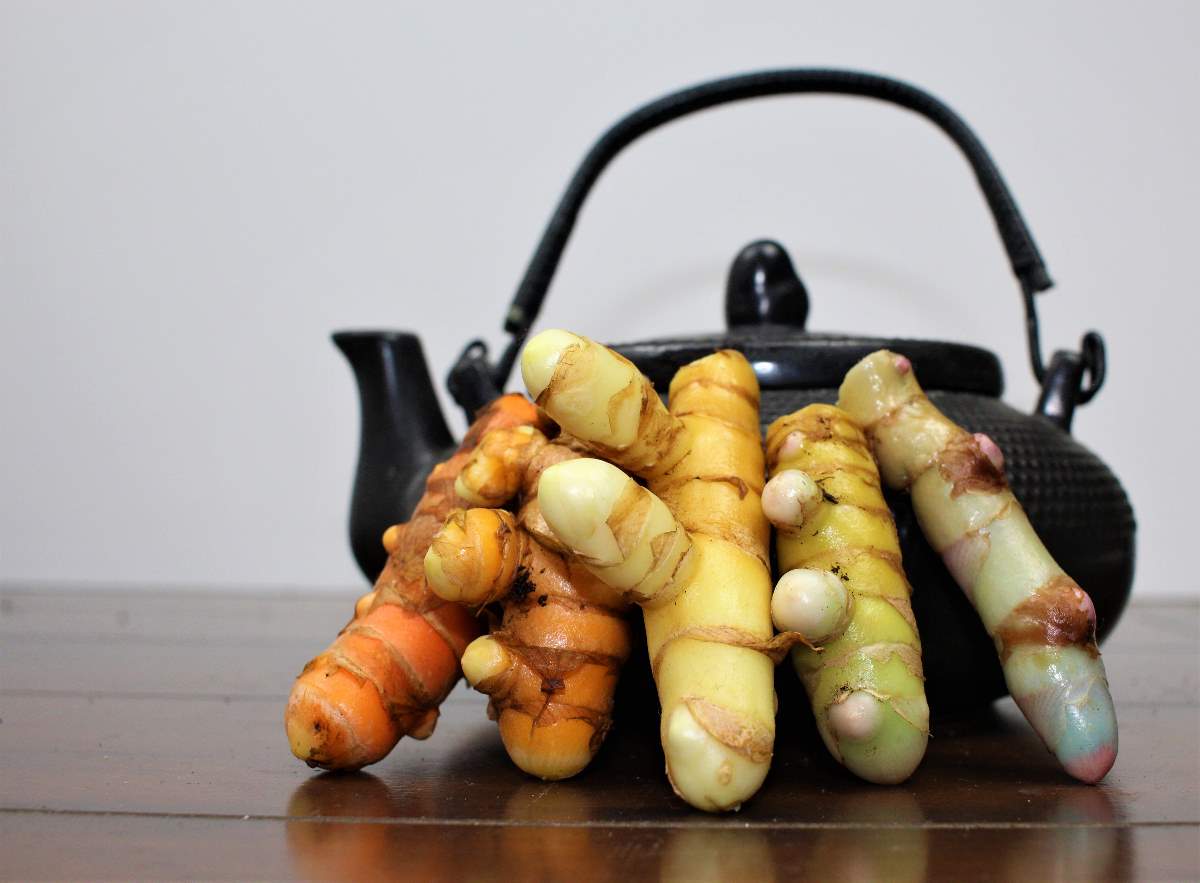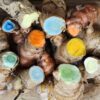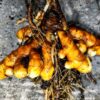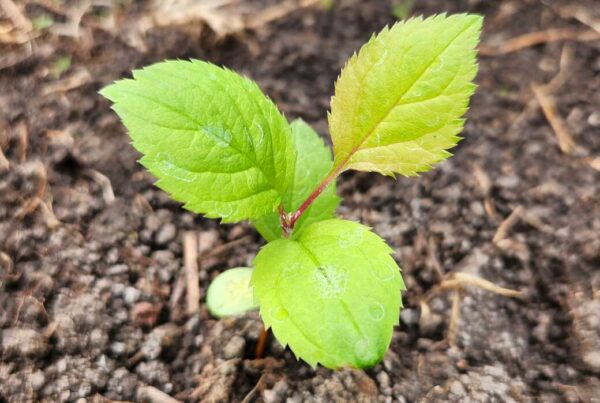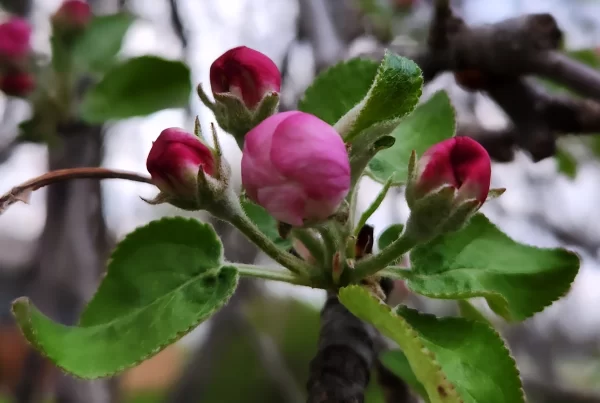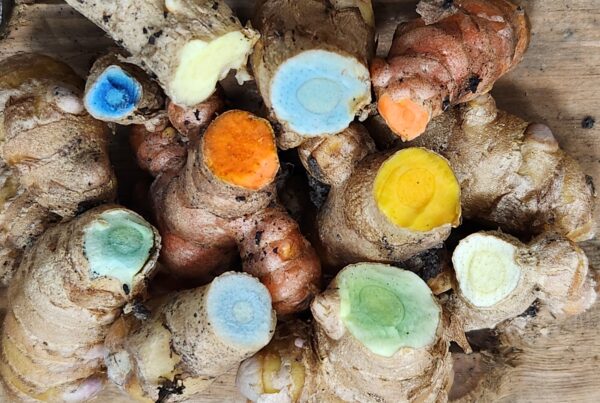
Why grow a turmeric rainbow?
Personally, I like the challenge of learning about and growing uncommon plants. Maybe this is also why you want to grow your own turmeric rainbow. Or maybe you are looking to improve the culinary or medicinal variety of your garden. All the below turmerics have been shown to contain powerful anti-inflammatory agents and antioxidants. If you are new to turmeric growing, I recommend you start here first. You can grow turmeric outdoors in zones 8 and warmer, or in pots/greenhouses elsewhere.
This post will discuss the following types of turmeric:
Red Hawaiian (curcuma longa)
Regular orange (curcuma longa)
Mango ginger/white turmeric (curcuma amada)
Green turmeric (curcuma longa)
Black/Blue turmeric (curcuma caesia)
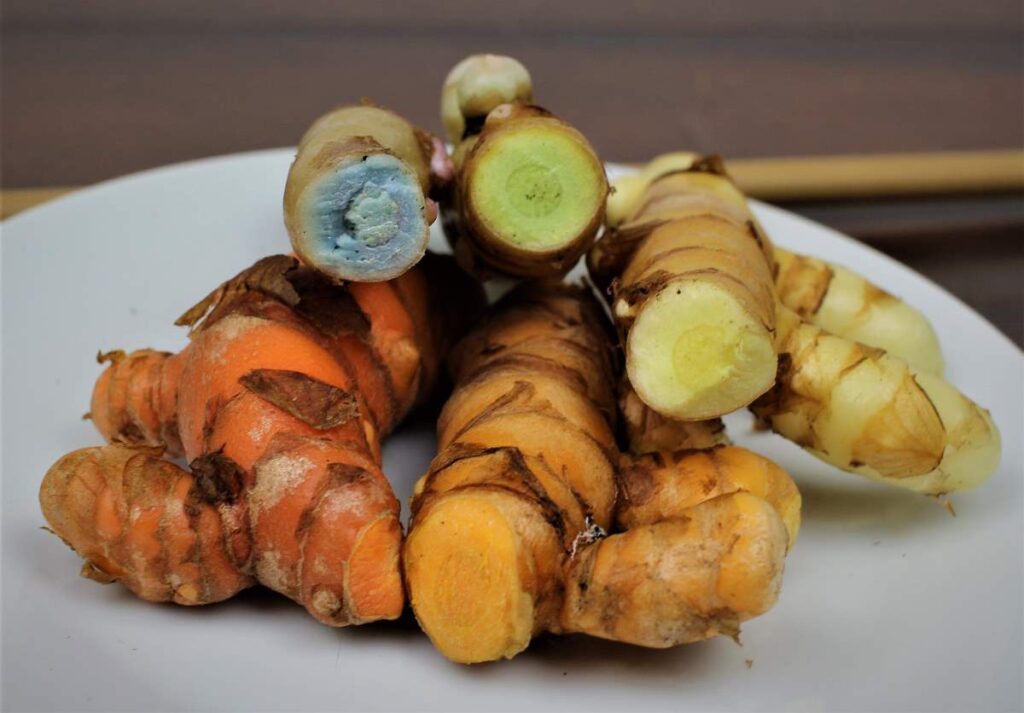
Red Hawaiian Turmeric (curcuma longa)
Red turmeric is more of a bright orange color than a true red, but it is easily distinguishable from regular orange turmeric. For a comparison, see the picture above. The red turmeric is on the left, and is a brighter hue than the regular turmeric. Its flavor is somewhat milder and less bitter than your standard turmeric. Some describe the taste as sweet. These qualities make red Hawaiian turmeric a culinary favorite. I have seen these fresh rhizomes for sale for $10 or more per pound.
Foliage is bright green and tropical looking. Happy plants may produce (edible) white flowers with green and/or pink tips. Flowers are more likely on established plants. Leaves are also said to be edible, although I have yet to try.
Orange Turmeric (curcuma longa)
This is the standard turmeric sold in grocery stores, both in fresh (rhizome) and powdered form. Although not considered rare, you will often pay upwards of $6 a pound for fresh turmeric rhizomes. Thus I recommend growing it along with the fancier types if you enjoy using turmeric in recipes.
Research studies have shown regular turmeric to be a remarkable medicinal. For example, it has been shown to have anti-cancer, anti-inflammatory, and pain-relieving properties. Turmeric may also be protective of arteries and cognitive functioning. This post has links to related studies on turmeric.
Foliage and flowers are similar to those of Red Hawaiian turmeric, above.
White Turmeric/Mango Ginger (curcuma amada)
Mango ginger, or curcuma amada, is actually a close relative of turmeric (curcuma longa). This variety tastes less pungent/bitter than standard turmeric and is sometimes pickled or cooked and eaten whole. Some say it has a fruit-like or floral taste, but I sense a peppery sweetness. Mango ginger is rarely found in grocery stores and costs upwards of $12 per pound online.
Rhizomes are white to yellow inside. The plants can produce lovely pink flowers once established, which is a bonus if you like your edible garden to also be beautiful. Foliage is bright green and similar to standard turmeric.

Green Turmeric (curcuma longa)
This is a rare, difficult to find turmeric. Most commonly used for cooking or smoothies, this variety can also be ground for use as turmeric powder. A small taste sample indicated this variety is somewhat less pungent than the standard orange variety. However, I make no definitive conclusions until a larger crop enables me to eat more. I have never seen fresh green turmeric available in grocery stores, although I have occasionally seen it available in powdered form online.
Rhizomes range from a light to a lime green hue. These plants have bright green leaves with a light purple stripe down the middle. As this was my first year growing green turmeric, I have no firsthand knowledge of flower characteristics yet.
Black/Blue Turmeric (curcuma caesia)
Black/Blue turmeric, or curcuma caesia, is another rare plant. Curcuma caesia is typically used medicinally, due to the higher content of curcumin (one of the active anti-inflammatory compounds in turmeric) and bitter taste. You can take black/blue turmeric internally in the form of pills or liquid extracts. You can also use it as a poultice to relieve swelling or soreness of injuries or inflammatory conditions.
Rhizomes range from light to deep blue. These plants have green leaves with deep purple stripes, which tend to be thicker than the purple markings of green turmeric. Purple/deep pink flowers can emerge from mature plants. I would rate them highly for a medicinal or ornamental garden. According to a recent news article, this type of turmeric is currently all the rage.
Grow a turmeric rainbow!
Due to our recent move, I had to significantly downsize my turmeric stock this past fall. However, we plan to build a greenhouse this year in order to house and expand our turmeric collections. You can find us at the Orange City, IA farmer’s market this summer (2025). We plan to have fresh vegetables, fruits, mushrooms, and herbs available this season. We’ll also be selling extra produce at our road market stand in Alton. Feel free to reach out if you’re looking for anything in particular! We can be reached at [email protected].
Have you tried growing any special curcumas? Do you have plans to grow a turmeric rainbow? Add your voice to the conversation below!

